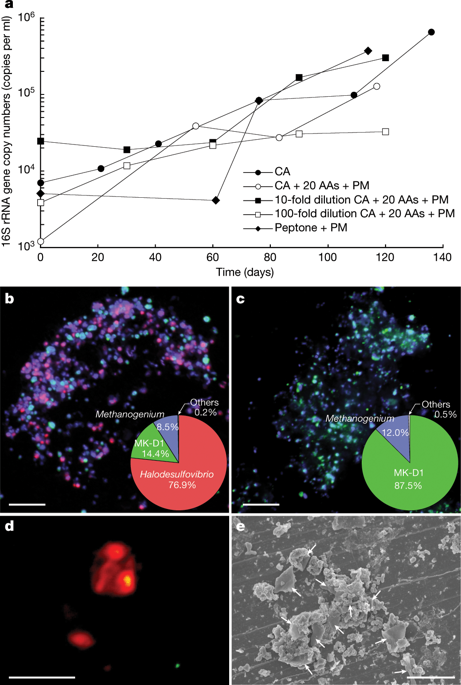Nature ( IF 50.5 ) Pub Date : 2020-01-15 , DOI: 10.1038/s41586-019-1916-6 Hiroyuki Imachi 1 , Masaru K Nobu 2 , Nozomi Nakahara 1, 2, 3 , Yuki Morono 4 , Miyuki Ogawara 1 , Yoshihiro Takaki 1 , Yoshinori Takano 5 , Katsuyuki Uematsu 6 , Tetsuro Ikuta 7 , Motoo Ito 4 , Yohei Matsui 8 , Masayuki Miyazaki 1 , Kazuyoshi Murata 9 , Yumi Saito 1 , Sanae Sakai 1 , Chihong Song 9 , Eiji Tasumi 1 , Yuko Yamanaka 1 , Takashi Yamaguchi 3 , Yoichi Kamagata 2 , Hideyuki Tamaki 2 , Ken Takai 1, 10

|
The origin of eukaryotes remains unclear1,2,3,4. Current data suggest that eukaryotes may have emerged from an archaeal lineage known as ‘Asgard’ archaea5,6. Despite the eukaryote-like genomic features that are found in these archaea, the evolutionary transition from archaea to eukaryotes remains unclear, owing to the lack of cultured representatives and corresponding physiological insights. Here we report the decade-long isolation of an Asgard archaeon related to Lokiarchaeota from deep marine sediment. The archaeon—‘Candidatus Prometheoarchaeum syntrophicum’ strain MK-D1—is an anaerobic, extremely slow-growing, small coccus (around 550 nm in diameter) that degrades amino acids through syntrophy. Although eukaryote-like intracellular complexes have been proposed for Asgard archaea6, the isolate has no visible organelle-like structure. Instead, Ca. P. syntrophicum is morphologically complex and has unique protrusions that are long and often branching. On the basis of the available data obtained from cultivation and genomics, and reasoned interpretations of the existing literature, we propose a hypothetical model for eukaryogenesis, termed the entangle–engulf–endogenize (also known as E3) model.
中文翻译:

原核生物-真核生物界面古细菌的分离
真核生物的起源仍不清楚1,2,3,4 。目前的数据表明,真核生物可能是从一种被称为“阿斯加德”古细菌的古细菌谱系中出现的5,6 。尽管在这些古细菌中发现了类似真核生物的基因组特征,但由于缺乏培养的代表和相应的生理学见解,从古细菌到真核生物的进化转变仍不清楚。在这里,我们报告了与洛基古菌相关的阿斯加德古菌从深海沉积物中分离出来长达十年的时间。古细菌——“ Candidatus Prometheoarchaeum syntropicicum”菌株 MK-D1——是一种厌氧、生长极其缓慢的小球菌(直径约 550 nm),通过共养降解氨基酸。尽管 Asgard 古细菌被认为具有类似真核生物的细胞内复合物6 ,但该分离株没有可见的细胞器样结构。相反, Ca . P. syntropicum 形态复杂,具有独特的长且经常分枝的突起。根据从培养和基因组学中获得的可用数据以及对现有文献的合理解释,我们提出了真核发生的假设模型,称为缠结-吞噬-内生(也称为 E 3 )模型。











































 京公网安备 11010802027423号
京公网安备 11010802027423号